AAQEP Accreditation
Standard 1 Aspect E
Standard 1e: Evidence shows that, by the time of program completion, candidates exhibit knowledge, skills, and abilities of professional educators appropriate to their target credential or degree, including: Creation and development of positive learning and work environments
Case for Standard 1e:
For this standard, we used 3 data sources: the Midterm and Final Fieldwork Evaluations,
Classroom Management Plan Assignment (SPED 125), and the SPED 219 Collaboration Assignment.
Data Sources & Analysis
Data Source 1
Midterm and Final Fieldwork Evaluations
Description of Data Source:
Candidates in the Education Specialist Program receive formal evaluations during both
their initial and final student teaching. For this data source, the program purposely
chose to report the results of the evaluations from both the midway and final stages
of three cycles (i.e., semesters) of student teaching. The University Coaches rate
candidates on a scale of 1-4, with 1 as “Does not meet Expectations” and 4 as “Exceeds
Expectations.”
Perspective Captured from Data Source: University Coach
Rationale for using Data Source:
The midterm and final field work evaluation are used by our clinical practice/fieldwork
coaches to provide observational feedback to student teachers at both the midway and
final stages of three cycles (i.e., semesters) of student teaching. It is the goal
of our special education program to create positive learning environments for all
students, including students with specific learning and behavioral needs. As a result,
our clinical practice coaches in the field of special education place a great deal
of emphasis on the creation and maintenance of learning environments that are inclusive
of students with diverse learning needs. Therefore, for this aspect, we included an
analysis of the midterm and final field work evaluations used by assigned candidate
coaches (clinical practice supervisors) to provide observational feedback to student
teachers. These feedback cycles occur twice each semester, once at the midpoint and
again at the end of the semester. Because candidates engage in two semesters of clinical
practice (initial student teaching SPED 171/SPED 172 and final student teaching SPED
175/SPED 176), this provides us the opportunity to study candidate growth over the
course of our program.
Specific Elements of Data Source:
Candidates’ scores for:
- Item 1: Positive Environment: Caring Community
- Aligned with TPE 2.1: Promote students' social-emotional growth, development, and individual responsibility using positive interventions and supports, restorative justice, and conflict resolution practices to foster a caring community where each student is treated fairly and respectfully by adults and peers.
- Item 2: Inclusive Learning Environment
- Aligned with TPE 2.2: Create learning environments (i.e., traditional, blended, and online) that promote productive student learning, encourage positive interactions among students, reflect diversity and multiple perspectives, and are culturally responsive.
Definition of Success for Each Element:
To measure growth on each item scale, it is our hope that coaching evaluations will
demonstrate high evaluation ratings (i.e., at least 4 out of 5) by the final evaluation,
along with an increase in scores within each semester (i.e., midpoint to the final
evaluation each semester) and growth from initial student teaching to final student
teaching placements.
Displays of Analyzed Data:
Figure 1: Fieldwork Evaluation, Item 1, 2020-21
Figure 2: Fieldwork Evaluation, Item 2, 2020-21
Link to Full Dataset: Midterm and Final Evaluations Dataset
Interpretation of Data:
Although ideally every candidate will demonstrate the highest (5 out of 5) scores
on coaching evaluations, it is notable that candidate scores for both mid and final
evaluations averaged 4.54 (out of 5) for Item 1 and 4.59 (out of 5) for Item 2. To
further support candidate growth in support of positive learning and work environments
we would like to continue to see an increase in evaluation scores for each item, both
at the completion of each semester as well as an increase in scores from initial student
teaching to final student teaching experience. We will continue to monitor progress
in these areas.
Data Source 2
SPED 125, Classroom Management Plan Assignment
Description of Data Source:
In SPED 125: Positive Behavioral and Social Supports, the goal of the Classroom Management
Plan is to create a meaningful, active instructional environment where rules, routines,
and expectations are clear, where more attention is given to desired behavior than
to inappropriate behavior, and where inappropriate behavior is managed systematically,
consistently, and equitably. To complete the Classroom Management Plan, candidates
1) develop a statement of purpose, 2) develop classroom rules, 3) develop classroom
routines and teaching methods, 4) develop an action plan which includes three parts:
a) lesson objectives, b) tasks necessary to meet objectives, c) completion date.
Perspective Captured from Data Source: Program Faculty
Rationale for using Data Source:
As a program, we believe that the ability to create a Classroom Management Plan that
is systematic, consistent, and equitable is critical to creating a positive learning
environment.
Specific Elements of Data Source:
Candidates’ overall scores for the Classroom Management Plan, scored using the Classroom Management Plan rubric
Definition of Success for Each Element:
We define success as students scoring 80% or above on this project. Figure 5 below
includes the 50 point rubric used to assess student work.
Displays of Analyzed Data:
Figure 3, SPED 125 Classroom Management Plan, Average Assignment Scores
Link to Full Dataset: SPED 125 Classroom Management Plan Dataset
Interpretation of Data:
The average score on this assignment was 47.2, well above our goal. Students successfully
completed the Classroom Management Plan assignment and were able to implement effective
strategies/procedures to create a classroom management system conducive to an optional
teaching and learning environment; i.e., one which fosters both academic and behavioral
excellence. It is recommended that future instructional emphasis should be placed
on continued observations and subsequent direction for student teachers as they apply
their plans to diverse student populations within a wide range of classroom settings.
Data Source 3
SPED 219, Collaboration Assignment
Description of Data Source:
A third measure that we use to evaluate the development of positive learning and work
environments is through the completion of the Collaboration Assignment in a required
course for all candidates in Special Education, SPED 219: Communication and Collaborative
Partnerships. The focus of this course is on the development of materials, strategies
and skills for individuals on the educational team to effectively and positively work
with students with a range of disabilities. Our teacher candidates take this course
while they are student teaching, thus they are able to use knowledge of classroom
practice in order to complete this assignment.
Based on the interests and needs of their classroom/school/community, candidates develop a project to demonstrate effective collaborative partnerships. They may choose to work individually, in groups, or the whole class can work together. Candidates are encouraged to work in groups and select an area of inquiry that interests them. If working in groups, the project must reflect the effort of the number of group members. The final class meeting serves as a showcase to present the projects to the class and others who are interested in attending.
Candidates work throughout the semester to complete this project collaboratively. Project choices include: Instructional Assistant Training Session, Parent/Family Training Session, General Education Teacher Training Session, Collaborative Partnership Website, Any Other Ideas or Suggestions. The projects are evaluated according to the brainstorming and assessment of needs, the planning of a group presentation, and the delivery of the group presentation.
Perspective Captured from Data Source: Program Faculty
Rationale for Using Data Source:
Candidates work throughout the course to create and develop a final assignment/project
demonstrating effective collaborative partnerships with various educational service
providers. We believe that the ability to create a positive learning and work environment
extends to the ability to work collaboratively with colleagues, which this assignment
requires candidates to do.
Specific Elements of Data Source:
Candidates’ overall score on the assignment, as evaluated by the rubric
Definition of Success for Each Element:
Our goal is that all teacher candidates will score 90% or above on this assignment
as successful completion of this course is required in order to become eligible for
a preliminary teaching credential in special education.
Displays of Analyzed Data:
Figure 7, SPED 219 Collaboration Assignment, Average Assignment Scores, 2020-21
Link to Full Dataset: SPED 219 Collaboration Project Dataset
Interpretation of Data:
What we found is that students’ average score was 100% (50 points). Students successfully
completed and presented to their class Community Engagement Projects which demonstrated
effective collaborative partnerships within a variety of settings. Students selected
options previously listed. These projects reflected the appropriate use of key communication/collaboration
partnerships covered within the course: problem solving, teamwork, consultation, co-teaching,
collaborating with paraprofessional educators, families, community organizations,
and administrators with an emphasis on supporting all students from multi-diverse
populations.
Next Steps Narrative:
This aspect is very important to us, thus the positive results of our self-study here
are gratifying. Still, our program’s goal is to continue building on these positive
results. In order to ensure the program’s ongoing success in this area, we will continue
to monitor coaching evaluation scores that support positive learning and work environments.
We believe that the process of examination and discussion of coaching evaluations
at both the end of each semester and upon the completion of clinical practice experiences
(i.e., student teaching) is important in ensuring that our program fosters teacher
candidates who are able to create positive learning environments.